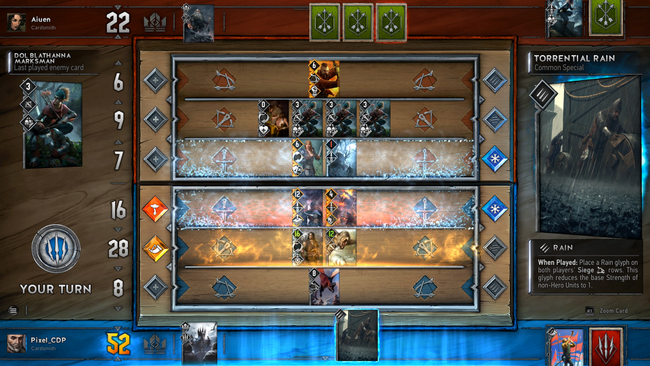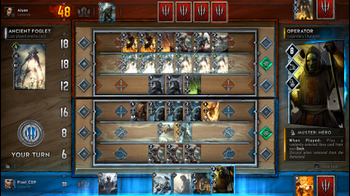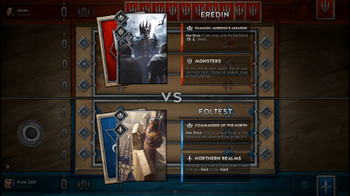
A Newcomer’s Peek into the World of Gwent’s Standalone Game

The prospect of diving into the realm of Gwent left me uneasy at first. I can’t say I’m all that familiar with the lore of the Witcher nor am I an avid player of card games these days. Put two and two together and it would seem like I would not be the most ideal person for whom Gwent is aimed at.
Luckily, seeing and playing Gwent for myself crushed these notions; I quickly realized that I didn’t need to be well-versed in the Witcher’s lore to simply have fun with Gwent.
Wearing a more colorfully vibrant and detailed UI, this standalone version of Gwent will not only be rebalanced to support its new competitive online multiplayer mode, but also contain new abilities, new mechanics, new factions, new modes, and of course, new cards. Some of these new cards will be powerful “Premium Cards” that display a lovely animated scene on them when selected.
Gwent’s standalone release isn’t just a simple job of copying and pasting its presence in The Witcher 3: Wild Hunt. Instead, CD Projekt RED has decided to expand Gwent as a tool to present untold stories in The Witcher universe through a single-player campaign.
Touted to be over 10 hours long, the campaign in Gwent is told through multiple perspectives – not just Geralt alone. Players will have to make difficult decisions that all carry their own unique set of consequences. CD Projekt RED stressed that they wanted to keep the spirit of the Witcher games’ storytelling as much as possible in Gwent.
The brief single player campaign demonstration starts off with the player’s party of Falibor, Geralt, and Milaen interacting with one another through a set of dialogue boxes between their portraits. Much of it is currently a work-in-progress with additional backgrounds and animations to be integrated, but Witcher fans that enjoy the story have a lot to look forward to.
An overhead world map lets players’ merry band freely travel from place to place visiting landmarks as they make their way to their destination. In the walkthrough, the party stumbles upon a ruin in shambles with the simple choice of investigating it or leaving it alone; investigating it led to new scenes that rewarded a new card to use in Gwent.
It’s unclear to me if cards obtained in the single player campaign will transfer over to competitive multiplayer decks, but I find the principle of strengthening your own deck as a result of the decisions you made to be an enticing hook to the single player part of Gwent.
Amusingly enough, the battles in Gwent’s single player are all represented through the card game; decks are made to characterize armies of opposing forces. Though this is no fault of the game itself, my mind likes to envision these encounters as everyone at a bar sitting down face-to-face in a civilized manner with card-mats in front of them. Of course, this is not the case at all but it’s a thought I’d like to entertain.
With the first look at Gwent’s single player campaign out of the way, it was time to get to business and experience Gwent for myself against the guy sitting across from me. I still wasn’t sure how to play the actual card game itself, so I figured a trial by fire would have to do.
What separates Gwent from the rest of many other card games is that you and your opponent only have ten cards to work with in your hand for the entire game – no more, no less. The goal for each round is to have a higher number than your opponent; once a player wins two rounds, they win the game of Gwent.
The number of cards in your hand is persistent between rounds meaning that if you used seven cards in the first round, you would only have three cards to work with in the next round. Therefore, both players are essentially playing an elaborate tug-of-war and decide how many resources to burn to secure a win.
A player may win the first round by spending most of her cards, but may have doomed herself in the rest of the rounds because she no longer has any cards to work with to gain the upper hand on her opponent.
Cards in Gwent are separated into three horizontal tiers with melee cards taking the front, ranged cards in the middle, and siege cards occupying the back. These cards don’t necessarily attack each other. Instead, each of them have a numerical value that feeds a player’s overall score for that round.
From there on, a plethora of other cards dictate whether these numbers increase or decrease. Some cards may summon other cards from a player’s deck. Meanwhile, other cards can banish an opponent’s strongest cards to their graveyard while another set of cards can resurrect cards from the graveyard to be played again.
Elemental effects and moles also come into play. Several cards cast weather effects, such as Frost or Fog, on entire rows that can strengthen or weaken cards. Players can also use Spy cards to plant a card in an enemy’s field that will up their score in exchange of crippling them in some other manner.
I found Gwent to be an easy game to learn, but it certainly has additional layers of strategic depth. Pitting certain decks against one another led to different ways of thinking to achieve victory; sometimes brute force is the answer, but sometimes it can work against you.
Manipulating and deceiving opponents by poking holes at their defenses seem to be the core strengths of Gwent’s approach to card games with additional bits of RPG elements tied to its single player campaign. I certainly wasn’t expecting Gwent to leave a lasting expression, but it left me quite surprised and something I definitely want to play more.
This standalone version of Gwent will be a free-to-play game coming to the PlayStation 4, Xbox One, and PC. The closed beta for Xbox One and PC starts in September with the PlayStation 4 version sometime after. The full release of Gwent won’t be out till sometime in 2017.
Gwent plans to have a cash shop, though CD Projekt RED has not disclosed what kinds of items will populate it. I sincerely hope that Gwent does not turn into a pay-to-win situation. It has a lot of potential and even though I probably wasn’t its intended target audience, I’m certainly more interested now in what just started out merely being a little card game in The Witcher 3: Wild Hunt.


